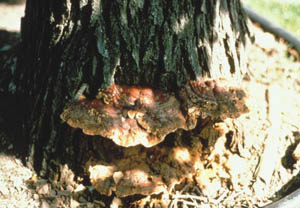Stressed Honeylocust��
June 14, 2007
Honeylocust trees have been showing decline and dieback in recent months--enough to generate quite a few inquiries at the Plant Clinic. Two major disease problems that we have seen are Thyronectria (Nectria) canker and Ganoderma root rot. Honeylocust plant bugs have caused some problems on new leaves, and anthracnose may be causing some leaf spots; but neither problem causes the reported branch dieback. Also keep in mind that honey-locusts are relatively shallow-rooted, so drought stress several years in a row may also be a factor.
Thyronectria canker is a fungal disease that appears on branches and trunks, causing the bark to turn orange-brown and later yellow/orange in the cankered area. The fruiting bodies of the fungus appear in the colored bark area as black, pinhead clusters. Thryonectria cankers are annual or perennial and are usually associated with branch crotches, pruning wounds, or sunburned bark. As with most canker diseases, stressed trees are most susceptible. Sinclair and Lyon, in their book Diseases of Trees and Shrubs, state that trees stressed by poor drainage and wet soils are most susceptible to infection. There are differences in varietal susceptibility in honeylocust. One study in Illinois reported the least cankering on Holka, Imperiel, and Shademaster, intermediate cankering on Moraine and Skyline, and the most cankers on Sunburst.
Ganoderma is a root-and-trunk-rotting disease known to invade wounds on roots and the base of the trunk. Environmental stress and wounding predispose trees to infection. The fruiting body of this fungus is readily visible. It is a large shelf fungus growing from the trunk, usually at a wound. The image shows a typical Ganoderma fruiting body.

Honeylocusts were planted to replace the elms on the U of I Quad when they died of Dutch elm disease in the 1950s. Many of those honeylocust have since died of Ganoderma root rot. Root compaction from foot traffic of thousands of students is thought to have been a stress factor. Most of those trees have been replaced with other tree species.
If you have a stressed honeylocust, do what you can to pamper it. Remove dead or cankered wood (in dry weather). Water the tree in periods of extended drought. Consider mulching over the root zone to maintain soil moisture and to provide more organic matter to the roots. Early-spring or fall fertilization may also help.
For more on canker diseases, refer to Report on Plant Disease, no. 636, "Canker and Dieback Diseases of Woody Plants" (Adobe PDF).
Author: Nancy Pataky
